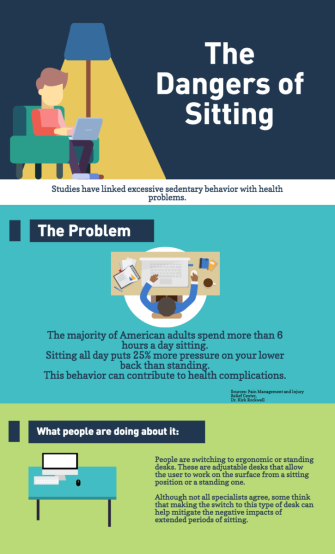Records Secretary Suzanne Ledbetter was one of the first Redwood staff members to make the switch to a stand-up desk after seeing one of her colleagues at Tam do so.
“Most of the people, including myself, do it for health reasons because the sitting is not good for you,” Ledbetter said.
Many staff and faculty at Redwood are making the shift to a more adaptable, flexible substitute: the ergonomic desk.

An ergonomic desk is a structure that allows the user to adjust the height of the desk.
Ledbetter said she has noticed a substantial decrease in discomfort because of her switch to the ergonomic desk.
She said that she was driven to switch to a standing desk because of her own physical ailment. However, she’s aware that there are other health benefits.
The increase in ergonomic desks began when a few teachers requested ergonomic assessments last year, according to Assistant Principal Larry Pratt. However, after various assessments proved costly, the district began taking requests based on medical needs only.
Assistant Principal Katy Foster said that she received an ergonomic assessment, which included an outside source’s professional opinion on purchasing office equipment to best suit her health needs.
English teacher Jeff Ryan swapped out his traditional desk for an ergonomical one in the fall semester.
“I don’t sit when I teach, so that was never an issue for me,” Ryan said. “When I have to do grading, especially stuff that’s computer based, I would find that if I had to sit for long periods of time, I was going home in pain. It was really bothering me.”
Ryan said he feels as though the change in desk type has significantly improved his teaching environment and alleviated his lower back pain, particularly when he has to grade papers for an extended period of time.
Sitting puts more pressure on the lower back than standing, according to San Rafael chiropractor Dr. Kirk Rockwell.
“One of the things to keep in mind as far as sitting is concerned is that you put about 25 percent more pressure on your lower back sitting than you do standing. If you were to do that through the course of the day, whether it be school or work, obviously that is going to build up, so it’s actually better for us to stand,” Rockwell said.

Rockwell recommends to his patients that they take frequent walking breaks throughout the day if they work in a job that requires them to stay seated for extended periods of time. Additionally, he said that there are ergonomic chairs that are designed to help make sitting more comfortable.
“If I have patients at work that have full back issues or mid back issues, one of the things I recommended for them is to try to get up and move around throughout the course of the day,” Rockwell said.
Rockwell said that he is not certain that standing desks help to mitigate the negative impacts of sitting; however, he has seen this switch be beneficial for some of his patients.
“It’s a different approach, it’s unique, to be honest I’m not quite sure if I’m 100 percent behind them or not,” Rockwell said.
Although standing desks have become somewhat of a new trend in many workplaces, some researchers disagree about whether they have real health benefits. Finnish researcher Dr. Jos Verbeek said that the desks have not been proven to be beneficial for your health during an interview with National Public Radio (NPR).
Though Verbeek claims there is no health benefit behind ergonomic desks, there are ergonomic chairs which are specially designed to provide lumbar support for the lower back, promoting better posture, according to the Canadian Centre for Occupational Health and Safety. Frequent breaks and specialized ergonomic chairs may also help minimize the risk of sitting-related health problems, such as back and neck issues.
While sitting excessively is not the direct cause of the aforementioned health complications, prolonged sedentary behavior may take a toll on person’s life expectancy, according to the British Journal of Sports Medicine.
In a study the Journal conducted in 2011, for every hour a person spends sitting, their life expectancy decreases by an average of 21.8 minutes because of the various health problems that are correlated with excessive sitting.
Studies by the Pain Management and Injury Relief Medical Center have shown that even one hour of exercise during a regular school or work day cannot undo the negative impact on the body’s insulin levels caused by prolonged sitting.
Although there are limited solutions available to minimize the repercussions of excessive sitting, small lifestyle changes can decrease these health damages. According to Biddle, incorporating physical movements throughout the day can help break up long periods of sitting and can be beneficial to a person’s health in the long run.
Ryan said that since he has made the switch to an ergonomic desk, he has seen marked improvement in his well being
“I feel better, I feel healthier, I feel more productive. I’m just happier at work,” Ryan said.

















